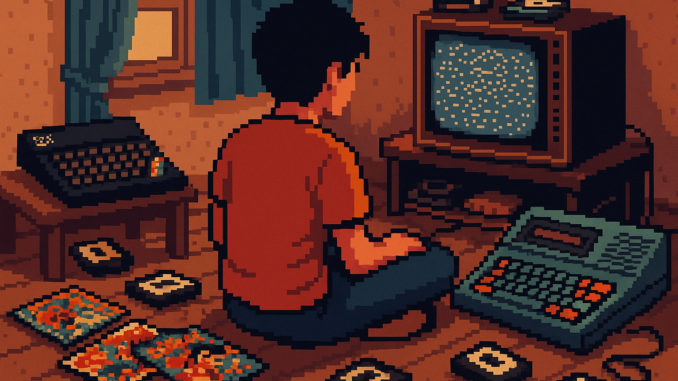
This is Part 5 of our ongoing series “Around the World in 8 Bits,” where we explore how home computing took root across the globe — not just in Silicon Valley or suburban Britain. If you missed Part 4, catch up with “Minitel to Microcode – France’s Digital Futures Before the Web.”
Prologue – Press Play on Tape
Madrid, 1985. It’s a Wednesday, it’s warm, and Miguel’s ZX Spectrum is screaming.
Not in fear — in data. A high-pitched screech bursts from his cassette deck as Fred loads from a home-dubbed tape. He copied it from his friend Jorge. Jorge got it from his cousin in Zaragoza. No one knows who bought the original.
“In 1985 Spain, you didn’t just play games. You duplicated them. Modified them. Drew cover art in the margins of maths books. It wasn’t piracy — it was participation.”
This was Spain’s 8-bit golden age — a riot of colour, noise, DIY artistry and regional software heroes who emerged from garages, basements, and dusty computer clubs with names like Micro Club 2000. The dictator was gone. The internet hadn’t arrived. And into that vacuum came something wild, pixelated, and totally Iberian.
Part 1 – From Censorship to Code
Ten years after Franco’s death, Spain was reinventing itself. Democracy, punk rock, and new tech arrived hand-in-hand. Kids weren’t just allowed to question things — they were encouraged to. And for many, that questioning happened on computers.
The ZX Spectrum was everywhere — cheap, cheerful, and British-built, with 48K of RAM and a rubber keyboard. Amstrad CPCs followed close behind, boasting built-in cassette decks, colour displays, and 64K memory — they felt like full stations, not just consoles. MSX, Dragon 32s, and even Oric-1s appeared via backdoor imports.
Spain didn’t make many 8-bit computers — in fact, it lacked a major domestic manufacturer altogether. But it made a whole lot of 8-bit culture.
Tape-to-tape copying became a national pastime. Swapping BASIC games at school. Dubbing pirate tapes. Loading errors. Magazine listings. No manuals. No safety net. Just pure enthusiasm and trial-and-error.
“We didn’t know what we were doing,” says Julio López, who now runs a digital archive of Spanish cassettes. “And that was the magic.”
Part 2 – The Golden Age of Spanish Software
From 1984 to 1992, Spain became a mini game-development powerhouse. Not by market scale — but by cultural fire.
Dinamic Software was the breakout star. Its founders were teenagers. Their first game, Yenght, was coded in a bedroom. They later released hits like Abu Simbel Profanation and Game Over, complete with heavy metal cover art and cheeky ads.
Topo Soft, Opera Soft, and Zigurat followed. Together, they created games that blended Spanish humour, architecture, history, and surrealism.
La Abadía del Crimen wasn’t just a platformer — it was a playable version of Umberto Eco’s The Name of the Rose. Made by a university student. With no save function.
Games were hard. Unforgiving. Often beautiful. Inspired as much by Mortadelo y Filemón comics as by Miyamoto. They sold like music singles — in kiosks, newsstands, and post offices. Colourful plastic cases. Six games for 395 pesetas.
Spain wasn’t copying the UK or the US. It was building something of its own.
Part 3 – The Fadeout
By the early ’90s, it was over.
16-bit machines rolled in. Sega and Nintendo arrived. Spanish kids moved to consoles, and the local studios couldn’t scale. Piracy worsened. Retail collapsed. The golden age ended not with a bang, but with a quiet reboot noise.
Many of the original games were lost. The source code vanished. Development teams disbanded. But the myth endured.
“They weren’t polished. But they were ours,” says Rebeca Salvatierra, now a retro game curator. “They came from our language, our jokes, our weird little stories.”
Part 4 – Retro Never Died
Spain’s 8-bit legacy didn’t vanish. It just went underground — then online.
By the 2000s, emulator communities like El Mundo del Spectrum began restoring, preserving, and even re-coding old Spanish games. ROMs were rescued from tape. Lost titles were reissued. Bugs fixed.
Events like RetroMadrid and RU MSX brought fans together. Indie devs built new games for 40-year-old machines — sometimes better than the originals. One standout revival is CPCRetroDev, an annual Amstrad CPC game development competition run from the University of Alicante. Dozens of teams create brand-new titles for 40-year-old hardware — some coded directly on original machines. The Amstrad CPC’s blocky graphics and AY-3-8912 sound chip quirks have become iconic — a kind of digital dialect for Spanish devs. It’s not just tribute. It’s a living platform.
Artists, musicians, and pixel wizards began mining Spain’s 8-bit archive for inspiration. Chiptune albums. Demo scene parties. ZX Spectrum vinyl soundtracks. You name it.
“It’s not nostalgia,” says indie dev Pablo Ordóñez. “It’s continuity. That era never really ended. We just paused the tape.”
Conclusion – What Freedom Looks Like in 48K
Spain’s 8-bit revolution wasn’t orchestrated. It wasn’t subsidised. It wasn’t even supposed to happen. But it did — because people wanted it to.
They coded in bedrooms. Hacked in school libraries. Wrote BASIC in notebooks. Rewound tapes and tried again. It was loud. Local. And full of life.
“In Spain, computing wasn’t clean or corporate. It was messy, brilliant, and gloriously Spanish,” Tom writes in his notebook before clicking save. “If you want to understand the soul of 8-bit Europe — load a game, press play on tape, and wait. It’ll come.”

Leave a Reply